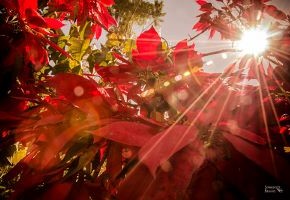
Winter — and the sweet relief of winter break — is finally here. CSUN students (and staff and faculty) have overcome the harsh challenges of finals, and the 2023 year is drawing to its close. But life is more than tests and presentations! In this Cited at the Library blog entry, we invite you to meditate on the natural world and its coming season by exploring some of the truly special, but perhaps less acknowledged, miracles and traditions of Winter.
Hibernation
Many animals hibernate during the winter months. Hibernation is a state of inactivity that allows animals to conserve energy when food is scarce. During hibernation, an animal’s body temperature drops, its heart rate slows down, and its breathing becomes shallow. Some animals, like bears, hibernate for several months, while others, like chipmunks, hibernate for just a few weeks. Whether it’s bears in deep slumber or smaller creatures in lighter sleep, hibernation is a critical adaptation that enables them to endure the challenges of winter when food becomes scarce. The process involves substantial weight gain, especially for bears, as they accumulate layers of fat for energy reserves during the hibernation period. Even for humans, the phenomena of ursine (bear-related) hibernation brings a certain joy — like the National Park Service’s annual Fat Bear Competition.
Winter Solstice
The winter solstice is the shortest day of the year and the longest night, and marks the first day of Winter. For those of us in the Northern hemisphere, this year’s winter solstice occurs on December 21st. This year, you might mark the occasion by dropping into your nearest Los Angeles Public Library branch for a cozy activity such as:
- Yalda: Winter Solstice Celebration (in Persian) at Mar Vista Branch – Tuesday December 19 at 5:30pm
- Solstice Art for Kids at the Memorial Branch – Thursday December 21 at 1:00pm
- Social Knitting and Crocheting Club at West Valley Regional Branch – Thursday December 21 at 4pm (and every Thursday)
- Posadas Navideñas / Christmas Posada at Robert Louis Stevenson Branch – Thursday December 21 at 5pm
Saturnalia
In ancient Rome, the winter solstice was celebrated with the festival of Saturnalia, which honored the god of agriculture, Saturn. During this festival, people would exchange gifts, decorate their homes with wreaths and other greenery, and feast with family and friends. Saturnalia was a festival held in ancient Rome in honor of the god Saturn. It was celebrated from December 17th to December 23rd and was a time of feasting, gift-giving, and general merrymaking. The festival was also marked by the lighting of candles and the exchange of small gifts, such as figurines made of clay or wax. Coinciding with the winter solstice, it marked the transition from darkness to light. During this festive period, social norms were temporarily set aside, and people engaged in a spirit of generosity, gift-giving, and communal celebrations.
Cuetlaxóchitl
One of the most recognizable flowers this time of year, particularly in the Americas, is the cuetlaxóchitl, also called nochebuena or poinsettia. Cuetlaxóchitl is a flowering shrub plant indigenous to parts of Mexico and Central America, especially southwestern Mexican and Guatemala. The iconic flower is noted for its distinctive bright red petals. Commonly thought of as a “Christmas flower,” cuetlaxóchitl was first cultivated by the Mexica (or Aztecs). It’s botanical and cultural history has been impacted by Catholic missions in Latin America as well as American imperialism — the plant’s common English-language name is traced to Joel Roberts Poinsett, diplomat from South Carolina and the first U.S. minister to Mexico. However, oral traditions from Nahuatl-speaking cultures connect the vibrant cuetlaxóchitl to the winter solstice, the birth of the Mexica diety Huitzilopochtli (Left-Handed Hummingbird), sacrifice and life force, and to the rebirth of Mother Earth. It’s traditional uses include medicinal applications and dye-making.
Manidoo-Giizisoons
In the Ojibwe calendar, which marks 13 moons, this time around December is known as “Little Spirit Moon”. With the advent of longer nights, this season is observed as an important time for storytelling. The stories themselves have a life of their own, and are significant teachers. The timing of this storytelling is significant, as it correlates with the time when the spirits, also, are in hibernation, and stories can safely be shared while they rest. Manidoo-Giizisoons will be followed by Gichi-manidoo-giizis, or “Great Spirit Moon.”
Join us at CSUN University Library as we explore the intertwined narratives of nature’s transformations and the timeless traditions that celebrate the spirit of winter. Together, let’s appreciate the cyclical beauty of renewal and rejoice in the interconnectedness of the natural world and human culture during this enchanting time of the year.
This blog post was written with assistance from ChatGPT 3.5 and Bing ChatAI. You can access a transcript of the drafting process on ChatGPT at this link.



